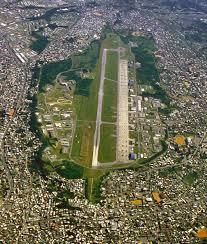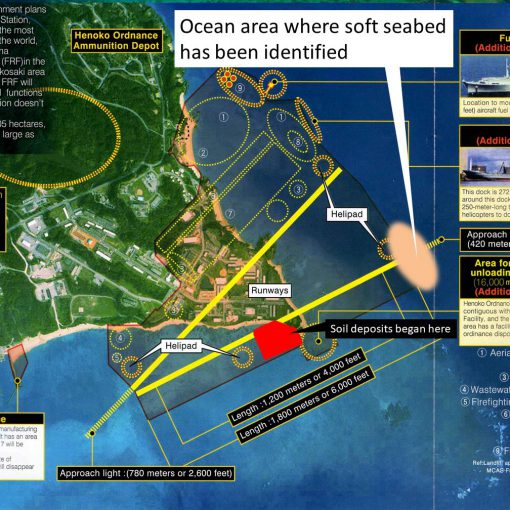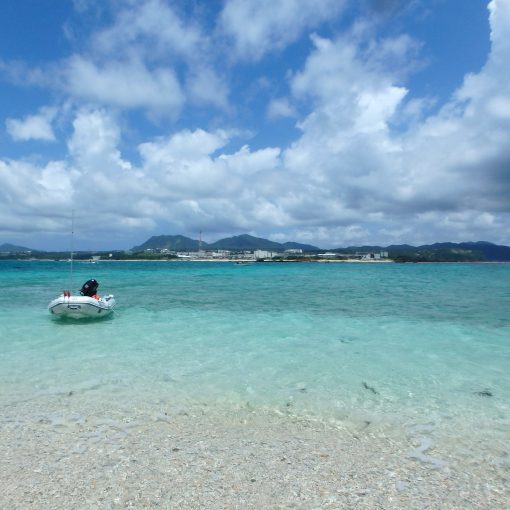KYODO NEWS – Feb 24, 2019 – 09:05


The following are questions and answers regarding the planned relocation of U.S. Marine Corps Air Station Futenma in Ginowan, Okinawa Prefecture.
Q: What is the relocation plan?
A: The Japanese and U.S. governments agreed in 1996 that the land used for the Futenma base will be returned to Japan as part of efforts to reduce the heavy U.S. military presence in Okinawa. In 1999, the Japanese government decided at a Cabinet meeting to build a replacement facility in the Henoko area in Nago, also in Okinawa.
Q: What served as the impetus for reaching an agreement?
A: In 1995, three U.S. servicemen raped a local schoolgirl, fueling anger and antibase sentiment among Okinawans.
Q: Why does the Futenma base have to be closed?
A: The base is often dubbed “the most dangerous airfield in the world” as it sits in a crowded residential area. In 2004, a helicopter from the Futenma base crashed at a university in Ginowan, injuring three crew members. In 2017, a window weighing 7.7 kilograms fell from a helicopter onto the grounds of a school just outside Futenma when children were taking classes, renewing safety concerns.
Q: What kind of base will be built in Henoko?
A: The Japanese Defense Ministry plans to reclaim some 160 hectares of land in waters off the Henoko area and construct two 1,800-meter V-shaped runways.
Q: Why are many Okinawa residents opposed to the relocation plan?
A: Despite accounting for only 0.6 percent of the country’s land mass, Okinawa is home to about 70 percent of the total area of land exclusively used by U.S. military facilities in Japan. Many Okinawa residents are fed up with noise, crime and accidents linked to the presence of the bases and do not want to see any new bases built in the prefecture.
Q: Why does Okinawa host the bulk of U.S. military facilities in Japan?
A: Okinawa was a battleground during World War II and U.S. bases were built on land expropriated from islanders during the postwar U.S. occupation that lasted until 1972. Okinawa remained under U.S. control for 20 years longer than the rest of Japan after the war.
Q: What is the Japanese government’s argument in moving ahead with the relocation plan?
A: Prime Minister Shinzo Abe’s government has maintained that the current plan is “the only solution” for eliminating the dangers posed by the Futenma base without undermining the deterrence provided by the Japan-U.S. security alliance.
Q: When will the land used for Futenma be returned?
A: A plan agreed between Japan and the United States in April 2013 said that the return of the land would be expected in fiscal 2022 at the earliest. But Japanese Defense Minister Takeshi Iwaya said in December last year that it will be difficult to keep to this schedule due to the wrangling between the central and local governments over the issue.
Q: How has Okinawa tried to block the relocation plan?
A: In 2015, then Okinawa Gov. Takeshi Onaga revoked the approval his predecessor gave in 2013 for land reclamation work to begin. The issue was taken to court, where the revocation was ruled illegal and Onaga rescinded it in 2016. On Aug. 31, 2018, the Okinawa government then retracted approval for landfill work, as instructed by Onaga before his death from cancer earlier the same month. However, the move was overridden by the central government.
Q: Is there anything left that Okinawa can do to halt the relocation?
A: The Okinawa government appears to lack effective measures to counter the central government. Okinawa Gov. Denny Tamaki, who won a gubernatorial election last September on an antibase campaign platform, has called for people to take part in the prefectural referendum on Sunday to express the “will of Okinawa.”





